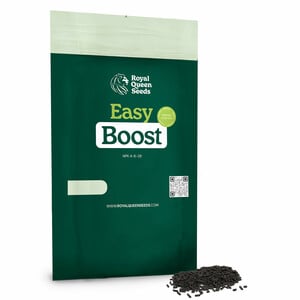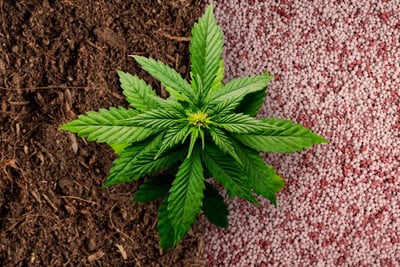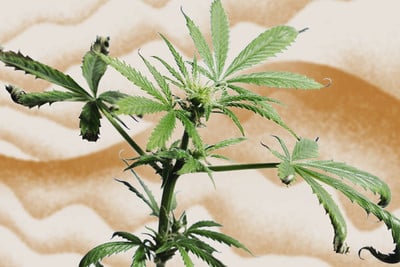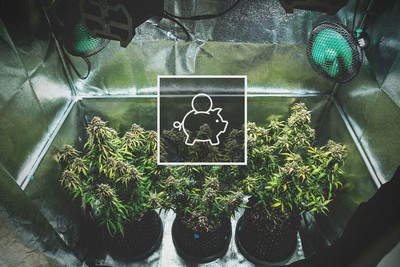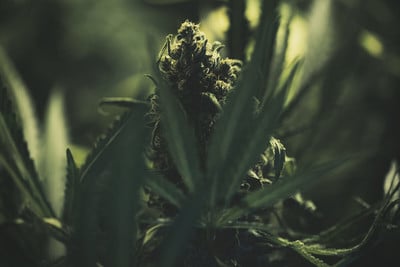.

How to Grow Weed on a Budget: Indoors and Outdoors
Growing cannabis doesn't have to be a huge investment. With the right tips, you can reduce the cost of your cannabis grow room/garden and grow top-shelf weed on a budget.
Explore our in-depth guide to growing weed on a budget.
Contents:
Growing cannabis on a budget can seem outright impossible to the uninformed. The cost of setting up and running a grow room, plus feeding and caring for your plants, can easily seem out of reach for the hobby grower. However, there are, in fact, many ways you can reduce the cost of your next grow-op to suit your financial constraints. In this article, we share our top tips for growing cannabis on a budget, both indoors and outdoors.
General Money-Saving Tips for Cannabis Growing
Cutting the costs for your next grow can be a lot easier than it might seem. Below are a few simple tips to help you save money when growing weed, indoors or out.
-
Choose Your Seeds Wisely
While it might seem counterintuitive to buy seeds when you’ve got the chance to grow bagseed for free, investing in quality cannabis seeds from the get-go has the potential to save you money (and stress) in the long-run.
When you buy seeds from a respected seed bank, you’re paying for guaranteed quality. Established seed banks have teams of dedicated breeders and growers constantly working to improve their genetics. That means, after germinating your seeds, you can rest assured the plants in your garden will grow strong and healthy (given the right care, of course) and reward you with good yields of top-shelf bud.
Buying autoflower seeds is another great way to save money. Today’s auto strains have the potential to produce great yields and excellent buds, with the potency and flavours to stand up to any photoperiod strain. If you’re a budget grower, make sure to go auto for your next grow.
-
Grow From Clones
The cost of buying new seeds after every harvest can add up, especially if you’ve got a big garden and grow several plants at a time. Cloning can offset some of those costs, giving you the opportunity to reproduce your favourite strains without having to invest in new seeds every time.
Keep in mind, however, that cloning also comes at a cost. In order to get good results, you’ll want to take your clones from a robust, healthy mother plant, which you’ll need to keep in constant vegetation. Keeping a mother requires space, a constant 18/6 light cycle, and plenty of fertiliser. But, in return, you’ll get the opportunity to take numerous clones from your mother every few weeks, potentially for years to come.
Note that, over time, the yield potential of mother plants tends to go down. To deal with this, most growers renew their mother plants every 6–12 months. In general, we recommend buying seeds, keeping the healthiest plant from your seeds as a mother, and cloning it for 6 months before repeating the process. This will help ensure you’re always working with healthy plants.


-
Use All Parts of the Cannabis Plant
Cannabis is an amazing plant with tons of uses. Unfortunately, many growers forget that at harvest time. The stems and leaves many growers misprize post-harvest can be used to make tea, cannabutter, infused cooking oils, lotions and topicals, and much more. Make sure you hold onto these parts of the plant next time you harvest to reduce the waste of your grow-op.
-
Reuse and Recycle
Let’s be honest; chances are you're going to conduct more than one cannabis grow in your lifetime. Hence, make the effort to reuse and recycle as many of the products/tools you use in your grow room as possible. Some obvious grow tools you can reuse include:
- Pots: Unless they are broken, there is no reason you shouldn’t be able to reuse your cannabis pots for multiple grows. Just make sure you fully sanitise each container before planting a new specimen.
- Soil: Quality soil is one of the biggest costs of a cannabis grow room/garden. Luckily, you can reuse old soil pretty easily. Just know that you'll need to supplement some new material into your old soil to boost its nutritional value and structure.
- Hoses, pruning shears, gardening gloves: If you’ve got gardening equipment you use for other plants, don’t go out and spend more money on extra tools for your cannabis garden. Simply sterilise your tools before each use (where necessary) to avoid spreading pests and disease from your cannabis plants to the rest of your garden, and vice versa.
- Try composting: If you want to take things a step further and save even more, consider composting the organic waste from your house (such as vegetable scraps, paper, and cardboard). Composting is very simple and, while it takes some time, produces an excellent, nutrient-rich growing medium for your plants. Best of all, composting is virtually free. All you need is a compost bin (any old bucket, bag, or pot can work), time, and some composting worms (technically optional; composting without worms just takes a little longer).
How to Grow Cannabis Indoors on a Budget
Growing cannabis indoors is generally more expensive than growing outdoors. In order to achieve healthy plants in a room or tent, you’ll need grow lights and fans to recreate the conditions cannabis naturally flourishes in outdoors. Below, you’ll find a list of ways to cut the cost of setting up/running an indoor grow room.
-
Build a Grow Room Out of an Old Cupboard or Closet
Rather than forking out top dollar for a grow tent, consider transforming a spare cupboard or closet in your house into a grow room. Just remember that you’ll want to cover the walls of whatever space you use with a reflective material (white plastic or Mylar film work best). This will reflect more light onto your plants, making for a more efficient grow room.
If you’re really short on space, consider building a micro grow room using an old computer tower.
-
Build Your Own Grow Tent
If you haven’t got a cupboard, closet, or old computer tower to refurbish into a grow room, consider building your own grow tent using basic materials like PVC pipe and panda film.
If you’re not the DIY type, try shopping around for a budget tent online. There are many grow tents on the market for as little as €50; just don’t expect them to be packed with features or have the best build quality, but they should last you at least a couple of harvests.
-
Utilise the Right Lighting
There are a ton of lighting options on the market, and finding the right solution for your grow room can be quite a task. If you’re growing on a budget, however, we generally recommend investing in a quality LED lighting panel.
While LED lights come at a higher outright cost than HID lights, they are much more efficient and cheaper to run, making them more cost-effective in the long-term. Not only that, but LEDs tend to run much cooler than HIDs, which is an important factor given the spatial limitations of most indoor budget growers.


-
Ventilate Your Grow Room
Ventilation is something growers shouldn’t skimp on, regardless of their budget. Extractor fans help pull old, stale air out of your room/tent so it can be replaced with fresh, oxygen-rich air from outside, while oscillating fans help keep air moving throughout your grow room. Both are super important for supporting the growth of your plants and keeping your room/tent free of pests and pathogens.
To reduce the cost of your ventilation system, make sure you buy an extractor fan with a m³/h rating that will ensure the correct air circulation. m³/h (cubic metre per hour) is an indicator of how much air an extractor can pull out of a space every hour. For proper ventilation, you’ll want to invest in a fan with a m³/h 70 times higher than the volume of your room/tent. This is because the average number of air exchanges required in a grow room is around 70 per hour.
For example, if you’re growing in a tent that measures 1m × 1m × 2m (with a total volume of 2m³), invest in an extractor fan with at least 140m³/h. You’ll want the smallest possible extractor that can effectively maintain an optimal, consistent temperature in your indoor garden. The smaller the extractor, the less power it’ll use, and the more money you’ll save.
Properly ventilating a small indoor grow space isn’t rocket science, but it’s essential nonetheless. If you can avoid the occurrence of pests, plagues, and inferior results for little money and effort, why not make your life easier?
Pro tip: We also recommend outfitting your extractor fan with a carbon filter to help reduce the smell of your grow-op.
-
Keep Temperatures Down
If you’ve followed our recommendations up until now, you shouldn't run into any issues with heat. Remember to use small oscillating fans to move air around your plants and keep old, warm air from getting trapped inside the room. You can also opt to run your grow lights during the night if you live in a very hot area.
-
Choose the Right Growing Medium
Soil is by far the most budget-friendly growing medium. If you want to further cut the costs of your grow-op, consider making your own super soil using compost, vermiculite, and organic fertilisers. As mentioned earlier, remember to reuse your old soil, if possible.
-
Grow With or Without Nutrients
While most growers opt to feed their plants with chemical fertilisers, there is a strong trend towards organics in the world of cannabis cultivation. In general, we always favour using organic fertilisers as they work with the soil to slowly deliver nutrients to plants.
Today, there are plenty of organic fertilisers on the market, and many of them come at a similar cost as their non-organic counterparts. However, using organic fertilisers might actually lower the cost of your grow-op in the long-run.
Chemical fertilisers are designed to be rapidly absorbed by a plant’s roots. Organic fertilisers, on the other hand, typically need to be broken down by microorganisms in the soil before they can be taken up by a plant. And, while you might favour the rapid absorption of chemical nutrients, the slower absorption of natural nutrients has a lot of benefits.
First of all, it's much harder (almost impossible) to overfeed plants using organic fertilisers. Second, chemical fertilisers typically leave salt deposits in the soil (unlike organic nutrients), which, over time, can build up and inhibit a plant’s ability to absorb nutrients and water from the substrate.
Finally, organic nutrients foster the growth of healthy microbial life in the soil, which helps to protect your plants from pests and pathogens. Hence, in the long-term, using organic fertilisers might actually save you money by leaving you with fewer problems in the grow room.
Some budget growers leave out nutrients altogether to further reduce the cost of their grow-op. While it's definitely possible to grow weed without nutrients, we don’t recommend doing so as your plants will likely produce much lighter and lower-quality yields.
-
Use Training Techniques to Your Advantage
There are countless ways to train cannabis plants to produce bigger yields of higher-quality bud. Some techniques can even help you save money by reducing the running costs of your grow room and the time it takes to get to harvest.
One of our favourite budget-friendly growing techniques is SOG (sea of green). Growing numerous small plants (either from seed or clone) close together is much faster and often less labour-intensive than growing fewer, larger plants and training them with LST, topping, etc.
To reduce the cost of your next grow, consider growing in SOG using small autoflowers or cuttings from a fast-flowering indica strain. You’ll enjoy good yields, and you’ll reach that harvest date much faster than if you were to grow and train two or three sativas.


A Cheap Indoor Grow Setup at a Glance
We have an article dedicated to figuring out how much your grow will cost, but here we’ll give a quick rundown of the numbers for a cheap indoor setup:
- Lights: around €80–170
- 1 Fan: €40+
- Grow tent: €70+
- Homemade grow tent: potentially almost free
- Exhaust €55+
- Thermometer/hygrometer: €13
- Pots: €8 each
These are average cheap prices, and there may well be cheaper options out there. Likewise, be creative. If you’re really on a budget, maybe those old pots from the garden are more suitable than new fabric pots.
Also, bear in mind that most of the things you need can be reused for years if treated well. So your first grow may see your bank account take a hit, but next time round, you might only need to pay for seeds!
-
What Else Can You Prepare For a Cheap Cannabis Grow Setup?
To get your grow off the ground with the perfect balance of low costs and proper plant care, you could do the following:
- Use high-quality autoflowering seeds/a clone from a high-performing mother plant.
- Grow in soil or super soil.
- Reuse/recycle. Reuse your pots, and even your soil.
- If you’ve already got adequate equipment for a task, see if you can use that!
- Make your own compost!
- Employ training techniques to get the most from each plant.
- Use an old cupboard instead of an expensive grow tent, or make a DIY grow tent setup.
- Microgrow: Go small but secure, focus on 1-2 plants and you will use less energy, less water and fewer nutrients in the process.
- Invest in LED lights; they will save you money over time.
- Ventilate! Though an initial expense, its ability to keep your crop healthy will pay off in the long run.
- Use all parts of the plant. After harvest, don’t just throw away the leaves and stems—make cannabutter or lotions.


How to Grow Outdoor Cannabis on a Budget
Growing cannabis outside allows you to harness the power of the sun and the unlimited fresh air of the outdoors. Nonetheless, there are a number of ways you can still reduce the costs of your outdoor grow op. Keep reading to learn more.
-
Choose the Right Location
Selecting the right location for your outdoor plant will maximise its growth and help you save on the costs of watering, building shading structures, and more.
Remember, cannabis is a tough, sun-loving plant. However, extreme temperatures (both cold and hot), harsh winds, and excessive rain can all damage your plants, leading to stunted growth, potential pest or disease issues, and reduced yields. By thinking ahead and picking the right location for your outdoor plants, you can avoid many of these issues—and the costs of rectifying them.
When your plants are young, we recommend keeping them in a spot that gets plenty of sun in the morning and early afternoon, but is shaded from the harsh midday sun. If you live in an area with heavy wind or rain, make sure to shelter your young plants from the elements to avoid any potential damage.
As your plants mature, gradually expose them to more sunlight. Always remember to pay close attention to the weather forecast and adapt your watering/feeding schedule around local rain or storms. Also, consider bringing top-heavy or flowering plants indoors during storms to avoid them toppling over or getting exposed to high humidity (which could in turn expose them to bud rot or other fungal issues).
-
Grow Sustainably
Sustainable cultivation is one of the best ways to cut the costs of your outdoor cannabis grow. Composting, companion planting, recycling water, organic feeding, and proper waste management not only reduce the environmental impact of your grow, but also help care for your back pocket.
Composting, for example, can help you save money on nutrients while also improving the microbial population in your growing medium. This, in turn, will help to protect your plants against pests and plagues, and will boost their health and vitality to boot. Meanwhile, improving your watering practices by incorporating greywater and recycling can also help drive down costs and improve the efficiency of your grow.
-
Choose Organic Over Synthetic
Growing organic cannabis is a lot easier outdoors. And, while most cultivators believe growing organic weed is more expensive than doing so synthetically, that isn’t always the case.
If you’re lucky enough to have an outdoor garden, you might be able to plant your cannabis directly in the ground. In that case, plants will have ample room to expand their root system, with access to natural soil rich in microbial life.
If you get good rainfall during the growing season, you might also be able to save money on watering. Most outdoor growers, however, keep their plants in pots to restrict their growth to some extent, and to allow them to move their plants if need be.
When it comes to feeding your plants organically, you can use the same organic fertilisers you would use indoors (mentioned above). If you’ve got the space and time, you can also make your own fertiliser using compost or compost tea made from fruit peels and vegetable scraps. In the end, these methods can be much less expensive than buying bottles of synthetic nutes.


-
Reusing Old Soil
As we mentioned earlier, reusing old soil is one of the best ways to reduce the cost of your grow-op, both indoors and outdoors. Outdoors, you can amend the natural soil in your garden with new material to improve drainage, aeration, and texture, as well as nutrient content, without pushing the boat out in terms of spending.
-
Use Autos or Fast Flowering Strains in Rough Climates
Unfortunately, not every cannabis grower lives in an area with a weed-friendly climate. If you're faced with a short growing season or poor weather, we recommend investing in autoflowering seeds or fast-flowering photoperiod strains to get to harvest quicker.
Aside from being speedy, autoflowers tend to withstand environmental fluctuations much better than the average photoperiod strain. This is due to the presence of ruderalis genetics, a cannabis subspecies that evolved in the harsh climates of Siberia and surrounding regions. As a result, autos will stand strong in the face of cold spells and other threats.
Growing Cannabis: Cost Versus Results
How much money to spend on your cannabis garden is completely up to you. But, remember that, while the quality of your harvest is somewhat dependent on how much money you can invest (especially indoors), growing good weed shouldn’t cost a fortune.
By following the tips in this guide, you should be able to produce a great harvest at home while keeping the costs of your grow to a minimum. Don’t expect to rake in 500 grams per plant, but you can still produce enough top-shelf weed to last you weeks, if not months. Good luck, and happy growing!


























